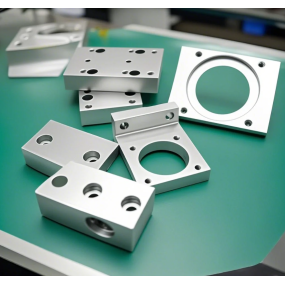The box body is mostly a surface that needs to be machined, such as medical boxes and gear transmission boxes. On these machined surfaces, it is easier to ensure flat machining accuracy than hole machining accuracy. Therefore, the machining accuracy of the spindle hole (main hole) and the machining accuracy of the hole system in the box are important issues in this process. For example, I have made a sound aluminum alloy chassis. Its advantages are: good heat dissipation, high CNC processing adhesion, four-star texture, easy maintenance, anodized surface, and a texture of up to five-star. Disadvantages: High processing conditions, high cost, and difficulty in personalized styling. The wooden chassis has poor heat dissipation, and high-end wood is expensive. Next, we will introduce an example of machining a helical gearbox.
Therefore, Wan Fuxin should pay attention to several points in the arrangement of the process route.
(1) Processing steps from face to hole
If you process the plane first, not only can you remove the rough surface and sandwich, but you can also simply draw the holes distributed on the plane for alignment. In addition, if the drilling knife starts drilling, there will be no impact vibration or tool damage due to uneven end faces. Therefore, it is usually preferred to process the plane first.
(2) Divided into rough machining and machining stages
The box structure is complex and requires high precision on the main surface. The cutting force, clamping force, and cutting heat generated during rough machining have a significant impact on machining accuracy. If rough machining is carried out immediately, the internal stress caused by deformation of the workpiece due to various reasons after rough machining cannot be completely released, and cannot be removed during machining, resulting in deformation after unloading the box and affecting the final accuracy of the box. I hope that during the rough machining process, the fixture can be loosened multiple times to release internal stress as soon as possible, thereby greatly ensuring the machining quality of the box.
(3) Decision on process concentration or dispersion
The separation of rough machining and processing stages of the box conforms to the principle of process dispersion. However, in order to reduce the number of machine tools and fixtures used in small and medium-sized production, and to reduce the handling and installation time of the box, the rough machining and processing stages can be relatively concentrated and configured on the same machine tool as much as possible.
(4) Arrangement of appropriate heat treatment process
The structure of the casting box is complex, with uneven wall thickness and inconsistent cooling rates during casting, which can easily generate internal stress and result in a hard surface. Therefore, it is necessary to arrange sandblasting and tempering personnel reasonably after casting.



 Spanish
Spanish Arabic
Arabic French
French Portuguese
Portuguese Belarusian
Belarusian Japanese
Japanese Russian
Russian Malay
Malay Icelandic
Icelandic Bulgarian
Bulgarian Azerbaijani
Azerbaijani Estonian
Estonian Irish
Irish Polish
Polish Persian
Persian Boolean
Boolean Danish
Danish German
German Filipino
Filipino Finnish
Finnish Korean
Korean Dutch
Dutch Galician
Galician Catalan
Catalan Czech
Czech Croatian
Croatian Latin
Latin Latvian
Latvian Romanian
Romanian Maltese
Maltese Macedonian
Macedonian Norwegian
Norwegian Swedish
Swedish Serbian
Serbian Slovak
Slovak Slovenian
Slovenian Swahili
Swahili Thai
Thai Turkish
Turkish Welsh
Welsh Urdu
Urdu Ukrainian
Ukrainian Greek
Greek Hungarian
Hungarian Italian
Italian Yiddish
Yiddish Indonesian
Indonesian Vietnamese
Vietnamese Haitian Creole
Haitian Creole Spanish Basque
Spanish Basque











